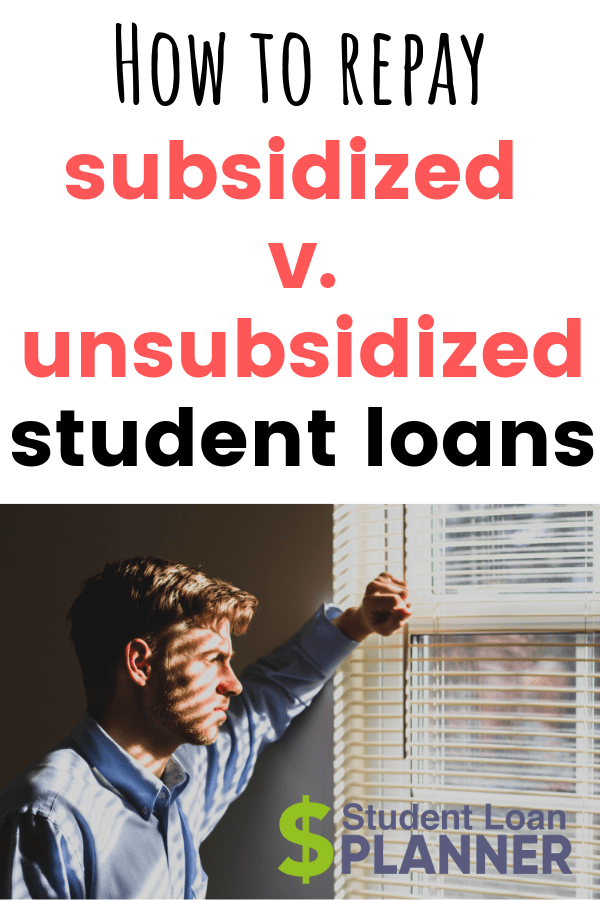
With current college costs, many students turn to federal student aid to earn their degree. The majority of those students receive help through student loans under the federal Direct Loan program. If you’re in grad school or recently graduated with an advanced degree, you might’ve taken on federal loan debt during your undergraduate studies.
But do you know if you have subsidized versus unsubsidized student loans? Figuring out what loan type you have is important before you plan your repayment strategy.
What is the difference between subsidized and unsubsidized loans?
Student loan interest on subsidized versus unsubsidized student loans is handled differently, which affects the way you’ll repay your loan debt.
What is a subsidized student loan?
Federal Direct Subsidized Loans are loans for undergraduate students who show a financial need. Students must complete the Free Application for Student Aid (FAFSA) to be eligible for Direct Subsidized Loans.
Your school determines your need based on your Expected Family Contribution (EFC) and other financial factors. It ultimately determines the maximum amount you can borrow within certain annual loan limits. The government sets the interest rate on these student loans, and they are relatively low compared to private student loans.
The U.S. Department of Education pays the interest on this type of federal student loan while you're in school. This means you’re not charged interest during this time. You must be enrolled at least half-time, and the grace period when you don’t pay interest after leaving school is six months. This rule is also in place during periods of deferment.
What is an unsubsidized student loan?
A federal Direct Unsubsidized Loan is available for undergraduate and graduate students. Unsubsidized loans also require students to complete the FAFSA, but they’re not based on financial need. Schools determine how much aid students receive. These decisions are based on the cost of attendance and other financial aid received.
Interest for federal Direct Unsubsidized Loans accrue as soon as funds are disbursed. This includes while you’re in school and into the six-month grace period after leaving school.
Interest on subsidized vs. unsubsidized student loans
Since interest is handled differently for subsidized versus unsubsidized student loans, it’s smart to think about how to strategically lower your interest charges overall. With the government footing the interest on subsidized student loans while you’re in school, it’s your federal Direct Unsubsidized Loan interest that’ll cost you more money.
As you’re completely responsible for interest on your loan, you have a couple of choices:
- Pay the interest while you’re in school
- Start paying interest after you’re out of school
If you decide to wait on paying the interest, interest will accrue and capitalize. This means your interest is added to the principal amount of your loan, and you’ll end up paying interest on your interest.
Here's an example:
Let’s say you have $15,000 in Direct Unsubsidized Loans from grad school. You also didn’t pay any interest during your six-month grace period. With a 6.6% fixed rate, the amount of interest that accrues on your loan per day is $2.71. Your loan will accrue interest totaling approximately $495. This $495 is added to your principal loan balance, making it $15,495.
Now, because capitalized interest is compounded, interest will now be calculated based on your new loan total. This will cause your interest that accrues daily to increase from $2.71 to $2.80.

Repayment strategies for grad students: Subsidized vs. unsubsidized student loans
Now that we’ve covered the difference between subsidized and unsubsidized student loans, what's the best way to tackle repaying these student loans? Here are a few strategies to keep in mind as you come up with a plan for repaying your subsidized and unsubsidized student loan debt:
- 20% rule. Interest accrues on unsubsidized loans from the start. If you aren’t making interest payments while in school, plan to repay 20% above what you originally borrowed.
- Pay it forward. Avoid having your interest accrue and capitalize by making interest payments while you’re in school. Whether this is a good idea for your situation depends on your repayment strategy (more on that later).
- Take what you need. You don’t get to choose how much financial aid you'll be awarded. But you can control how much you actually borrow. Only borrow what you need for school costs, loan fees and supplies. Just because you can max out high aggregate loan limits doesn't mean you should.
What options do you have for repaying your subsidized and unsubsidized loans? The good news is both types of loans offer several solutions for repayment. Which plan is right will depend on your specific situation and your repayment goals.
Income-driven repayment (IDR) plans
Both subsidized and unsubsidized loans allow you to take advantage of IDR plans. This is an excellent way to lower your monthly student loan payment as each plan is based on your discretionary income.
IDR Plans include:
- Pay As You Earn (PAYE)
- Revised Pay As You Earn (REPAYE)
- Income-Based Repayment (IBR)
- Income-Contingent Repayment (ICR)
In the end, if you aren’t pursuing loan forgiveness, you will pay more with an IDR plan. But if you need lower payments now, this is an option.
Public Service Loan Forgiveness (PSLF)
Another perk subsidized and unsubsidized student loans offer is access to PSLF. With PSLF, any student loan debt remaining after 120 qualifying payments is forgiven tax-free. To be approved for PSLF, you must be on one of the four qualifying repayment plans mentioned earlier.
Borrowers must fill out the PSLF Application for Forgiveness. This could be huge if you have unsubsidized grad school loans to pay off.
Income-driven loan forgiveness
If you aren’t planning on working in the public sector or don’t qualify for PSLF, another possibly beneficial option is IDR loan forgiveness. After signing up for an eligible IDR plan and making payments for 20 to 25 years, any remaining student loan debt is forgiven.
However, any forgiven debt with IDR loan forgiveness is considered taxable income. So, you could face hefty tax implications. Be sure to factor this in when deciding on a repayment plan for your student loan debt.
Note that part of the American Rescue Plan that was enacted in response to the COVID-19 pandemic carved out temporary tax-free loan forgiveness through December 31, 2025.
Refinance your federal Direct Unsubsidized Loans
If you have a large amount of unsubsidized student loan debt, you may be better off refinancing your student loans. You may be able to lower your interest rate or get better repayment terms. But this depends on whether you have excellent credit and other eligibility requirements.
Regardless of whether you have subsidized versus unsubsidized student loans, there’s a repayment strategy that’s right for you. If you need help figuring out the best path, we love making custom repayment plans for readers like you.
